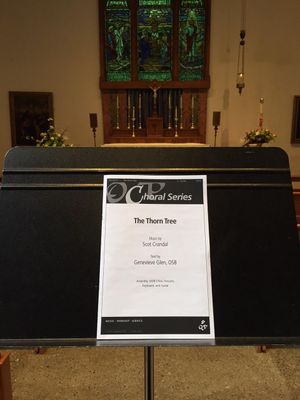The Thorn Tree
Recorded at St. Mary's Cathedral, Portland, Oregon, by the Trinitas Choir; James Denman, producer; Angela Westhoff-Johnson, conductor
Order through OCP (edition # 30132370)
- website: OCP
- email: liturgy@ocp.org
- phone: 1-800-liturgy (800-548-8749)
Usage
- Christmas and/or Easter
- Two versions included: 1) choral anthem version (SATB & Piano and/or Organ) and 2) simple hymn version

TEXT
In rock where time had carved a cave,
The Savior slept when he was born—
And underfoot lay stone and dust,
And overhead a tree of thorn.
At Gabbatha, where Pilate sat,
The Savior met with fear and scorn—
And underfoot lay stone and dust,
And overhead a bleeding thorn.
In rock where time had carved a cave,
The Savior slept, his body torn—
And underfoot lay stone and dust,
And overhead a broken thorn.
From rock where time had carved a cave,
The Savior rose on Easter morn—
And underfoot, a field of wheat,
And overhead, a flowering thorn!
Text: LM; Genevieve Glen, OSB, b. 1945, © 2004, The Benedictine Nuns of the Abbey of St. Walburga. Published by OCP. All rights reserved.
REVIEW
We expect to hear a big, extended anthem with brass on Easter Sunday. However, the Easter Season is long! This setting of a beautiful text by Benedictine Sister Genevieve Glen is perfect for the Sundays of Easter that don’t demand as much pomp and circumstance. Gifted composer Scot Crandal provides gentle music that perfectly compliments the exquisiteness of the text.“The Thorn Tree” begins with keyboard and unison women intoning the melody of the hymn (flowering thorn), which speaks of the cave where the Savior was born (“overhead a tree of thorn”). Verse two introduces two-part men singing of Gabbatha where Jesus was scorned (“overhead a bleeding thorn”). Verse three is four-part a cappella writing intimately recalling the cave where the Savior’s torn body slept (“overhead a broken thorn”). With the restoration of the keyboard, Crandal returns to unison with an added descant, evoking Easter morn as the Savior rose (“overhead a flow’ring thorn”). The progression of both the text and the music is striking.
For choirs that are not able to sing the choral parts, a unison hymn version is provided, along with an assembly edition. This accessible choral anthem is worthy of inclusion in any choral program to add to the beauty of the Easter season.
—Angela Westhoff Johnson
COMMENTARY
This hymn text was written after the fashion of a medieval carol. Medieval Christmas and Easter carols are simple songs that often borrow a symbolic image from nature—in this case, the thorn tree—and weave it into a repetitive text. Most frequently, the Christmas carols sing of Jesus’ birth in light of his death on the cross, as this text does. The repeated “stone” evokes the stone hearts, sealed like a tomb, into which Christ enters and from which he frees us, so that they become not tombs but fields of ripe wheat sprung from the grain that fell into the earth and died (verse 4). The “dust” evokes our mortality: from dust we came, to dust we will return—but the grains of dust, too, are transformed into wheat. The thorn tree evokes the suffering of Christ which makes this transformation possible: it overshadows his birth (verse 1), takes the form of a blood-stained crown of thorn during his passion (verse 2), seems broken and thrown away at his burial (verse 3), and finally bursts into flower, its beauty revealed, at his resurrection (verse 4).—Sr. Genevieve Glen, OSB
SCRIPTURE REFERENCES
Verse 1: Luke 2:7
Verse 2: John 19:2–3, 13–16
Verse 3: John 19:41–42
Verse 4: John 12:24
COMMENTS
"So gorgeous!" -Alice Speers
"Transcendent, Scot. I am glad to hear this." -Nevada Jones
"Lovely, absolutely lovely. Thank you for sharing." -Terri Kuechle
"I listened and that was awesome!" -Blair Raymond






